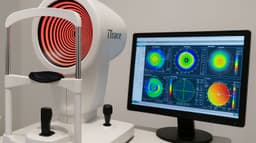
Navigating The World of Blepharitis For Clearer, Healthier Eyes
In the intricate tapestry of eye health, certain conditions warrant our attention for the discomfort they bring to our daily lives. Among these, blepharitis emerges as a common yet often overlooked concern. Blepharitis, characterised by inflammation of the eyelids, can disrupt the harmony of our visual experiences and prompt a quest for relief. In this exploration, we delve into the realms of blepharitis, unravelling its causes, symptoms, and avenues for effective management.
Beneath the delicate surface of our eyes lie the complexities of the eyelids, responsible for safeguarding this precious sensory organ. Blepharitis, akin to a discordant note in an otherwise melodious composition, can manifest in various forms – anterior or posterior, acute or chronic. Its impact extends beyond discomfort, affecting the health of the tear film, the clarity of vision, and even the aesthetic appeal of our gaze.
What Is Blepharitis?
Blepharitis is a common eye condition characterised by inflammation of the eyelids, specifically, the edges where the eyelashes grow. It's a chronic and often recurring condition that can cause discomfort, irritation, and a range of symptoms related to the eyes and eyelids. While it's not usually a serious condition, blepharitis can be bothersome and impact the quality of life for those affected.
There are two main types of blepharitis:
Anterior Blepharitis
This type affects the front part of the eyelids where the eyelashes are attached. It's usually caused by bacteria or dandruff from the scalp and eyebrows. Symptoms may include redness, swelling, itching, and flaking of the eyelid skin.
Posterior Blepharitis
Also known as meibomian gland dysfunction (MGD), this type involves dysfunction of the oil-producing glands in the eyelids (meibomian glands). It can lead to poor-quality tears and evaporative dry eye symptoms. Thickened or discoloured oil secretions may also be visible.
Common symptoms of blepharitis include:
- Red and swollen eyelids
- Itchy or burning sensation in the eyes
- Gritty or foreign body sensation
- Crusty or sticky eyelids, especially upon waking
- Excessive tearing or dry eyes
- Sensitivity to light
- Flaking or crusting at the base of the eyelashes
- Eyelashes that grow abnormally or fall out.
Blepharitis can be caused by a variety of factors, including bacteria, skin conditions like seborrheic dermatitis, certain medical conditions (like rosacea), and poor eyelid hygiene. Treatment aims to manage symptoms, prevent flare-ups, and improve overall eye comfort. It may involve a combination of warm compresses, gentle eyelid cleansing, medicated eyelid scrubs, artificial tears, and, in some cases, prescription medications.
Since blepharitis can have overlapping symptoms with other eye conditions, it's essential to consult an eye care professional for an accurate diagnosis and personalised treatment plan. Regular eyelid hygiene practices and proper management can help individuals with blepharitis experience relief and maintain good eye health.

How Do I Know If I've Got Blepharitis?
If you're experiencing certain symptoms related to your eyelids and eyes, you might be wondering if you have blepharitis. While only a qualified eye care professional can provide an accurate diagnosis, here are some common signs and symptoms that could indicate the presence of blepharitis:
Eyelid Redness
If your eyelids appear red, swollen, or irritated, it could be a sign of blepharitis.
Eyelid Itching
Persistent itching of the eyelids, especially at the base of the eyelashes, can be a symptom of blepharitis.
Burning Sensation
A burning or stinging sensation in your eyes, often accompanied by discomfort in the eyelids, could point to blepharitis.
Foreign Body Sensation
If you feel like there's something gritty or like there's a foreign object in your eye, it could be due to blepharitis.
Crusty or Sticky Eyelids
Waking up with eyelids that are crusty, sticky, or have oily debris near the base of the eyelashes is a common sign.
Flaking or Dandruff-Like Skin
Flaky or scaly skin at the base of your eyelashes might indicate blepharitis, especially if it's persistent.
Tearing or Dry Eyes
Both excessive tearing and dry eyes can be associated with blepharitis due to its effects on tear production and quality.
Eyelash Abnormalities
Changes in the appearance of your eyelashes, such as their growth direction or loss, could be related to blepharitis.
Sensitivity to Light
Increased sensitivity to light (photophobia) can occur along with other blepharitis symptoms.
Blurry Vision
In some cases, blepharitis can lead to fluctuating or blurred vision, particularly if it's causing dry eye symptoms.
If you're experiencing one or more of these symptoms, it's recommended to schedule an appointment with an eye care professional, such as an optometrist or ophthalmologist. They can perform a comprehensive eye examination, assess your symptoms, and determine whether you have blepharitis or any other eye condition. Remember that early diagnosis and proper treatment can help manage the symptoms and prevent potential complications associated with blepharitis.

What Are The 4 Stages Of Blepharitis?
Blepharitis is a complex condition that can manifest in various ways and may not always fit neatly into distinct stages. However, some sources describe blepharitis in terms of four general stages, each representing different aspects of the condition's progression and severity. These stages can help provide a general understanding of how blepharitis may evolve:
Stage 1: Mild Blepharitis
In the early stage, symptoms may be relatively mild and intermittent. Individuals may experience occasional eyelid redness, mild irritation, and a gritty or foreign body sensation. At this stage, symptoms may not be very bothersome, and people might not seek medical attention.
Stage 2: Moderate Blepharitis
As blepharitis progresses, symptoms become more noticeable and consistent. The eyelids may appear redder and more swollen, and individuals may experience increased discomfort, itching, and a sensation of burning. Crusting and flaking of the eyelid margins, particularly upon waking, may become more pronounced.
Stage 3: Severe Blepharitis
In this stage, symptoms intensify further. There may be significant inflammation of the eyelids, leading to pronounced redness, swelling, and discomfort. Individuals may experience frequent and persistent symptoms, including irritation, dryness, and blurry vision. The risk of developing complications like styes or chalazia is higher at this stage.
Stage 4: Chronic Blepharitis
Chronic blepharitis represents the long-term management phase. Symptoms may persist over extended periods, and individuals learn to manage and minimise flare-ups through regular eyelid hygiene practices, prescribed medications, and lifestyle adjustments. While symptoms are generally more controlled, they may still occasionally flare up, requiring ongoing care.
Moreover, these stages are not rigid categories, and individuals may experience variations in the progression and severity of blepharitis. Additionally, the specific characteristics of blepharitis can differ based on whether it's anterior or posterior blepharitis, the underlying causes, and individual responses to treatment.
What Happens If Blepharitis Is Left Untreated?
If left untreated, blepharitis can lead to a range of discomforts and potential complications. While it's generally not a sight-threatening condition, ignoring blepharitis can result in ongoing symptoms and increase the risk of other eye-related issues. Here are some possible consequences of untreated blepharitis:
Persistent Discomfort
The symptoms of blepharitis, such as itching, burning, and irritation, can become chronic and bothersome, affecting your overall quality of life.
Dry Eye Syndrome
Blepharitis can disrupt the normal functioning of the oil-producing glands in your eyelids, leading to poor-quality tears and evaporative dry eye. This can cause chronic dryness, discomfort, and even damage to the surface of the eye.
Stye Formation
Blepharitis can increase the likelihood of developing styes (hordeolum) – painful, red bumps that form on the eyelid due to blocked oil glands.
Chalazion Formation
Untreated styes can progress into chalazia, which are painless, larger bumps on the eyelid caused by inflammation of blocked oil glands. Chalazia can take longer to resolve and may require medical intervention.
Bacterial Infections
The inflamed eyelids and disrupted tear film can create an environment where bacterial growth is more likely, leading to recurrent infections.
Corneal Complications
Severe blepharitis can potentially affect the cornea, the clear front surface of the eye. Corneal complications can result in vision disturbances and discomfort.
Increased Risk of Allergic Reactions
Chronic inflammation from untreated blepharitis can make your eyelids more prone to allergic reactions to environmental allergens or contact lens solutions.
Eyelash Abnormalities
Without proper care, blepharitis can lead to changes in the growth direction of eyelashes, eyelash loss, or ingrown eyelashes (trichiasis).
Recurrence
Blepharitis tends to be a chronic condition that can recur if not managed. Ignoring initial symptoms may lead to ongoing cycles of discomfort.
Reduced Quality of Vision
Chronic dryness and irritation can impact the quality of your vision, especially if you spend significant time using digital devices or focusing on close-up tasks.
Moreover, addressing blepharitis promptly minimises these potential complications. If you suspect you have blepharitis or are experiencing symptoms, seeking professional guidance from an eye care specialist is recommended. They can provide an accurate diagnosis, recommend appropriate treatments, and offer advice on eyelid hygiene practices to help manage the condition effectively.
What Triggers Blepharitis?
Blepharitis can be triggered by a combination of factors, including poor eyelid hygiene, underlying medical conditions, and environmental factors. Understanding these triggers can help you take steps to manage and prevent blepharitis flare-ups. Here are some common triggers:
Poor Eyelid Hygiene
Not cleaning your eyelids properly can lead to a buildup of bacteria, oil, and debris along the eyelid margins, contributing to blepharitis.
Bacterial Infections
Bacteria, such as Staphylococcus aureus, can proliferate on the eyelids, leading to inflammation and blepharitis.
Meibomian Gland Dysfunction (MGD)
Dysfunction of the oil-producing glands in the eyelids (meibomian glands) can contribute to posterior blepharitis and evaporative dry eye.
Seborrheic Dermatitis
This skin condition can affect the scalp, face, and eyelids, leading to oily and flaky skin that can contribute to blepharitis.
Rosacea
Rosacea is a chronic skin condition that can cause facial redness and affect the eyes, leading to ocular rosacea, which can trigger blepharitis.
Allergies
Allergic reactions to pollen, pet dander, or other allergens can lead to inflammation and worsen blepharitis symptoms.
Contact Lens Wear
Poor contact lens hygiene, wearing contact lenses too long, or using solutions that irritate the eyes can contribute to blepharitis.
Makeup and Cosmetics
Using old or contaminated eye makeup or cosmetics can introduce bacteria and irritate the eyelids.
Environmental Factors
Dry and dusty environments, exposure to smoke or wind, and air conditioning can worsen blepharitis symptoms.
Hormonal Changes
Hormonal fluctuations, such as those during puberty, pregnancy, and menopause, can affect oil gland function and trigger or worsen blepharitis.
Systemic Health Conditions
Conditions like diabetes, autoimmune disorders, and certain inflammatory diseases can increase the risk of developing blepharitis.
Stress
Chronic stress and fatigue can weaken the immune system and contribute to inflammation, potentially triggering blepharitis.
Age
As people age, the function of the meibomian glands may decline, increasing the risk of blepharitis.
Everyone's triggers can be unique, and some individuals may experience blepharitis due to a combination of factors.

How Long Does It Take For Blepharitis To Clear Up?
The duration for blepharitis to clear up can vary widely depending on factors such as the severity of the condition, the underlying cause, the effectiveness of treatment, and an individual's adherence to recommended practices. Blepharitis is often a chronic condition, which means that while symptoms can be managed and improved, it may not be completely cured. Here's a general overview of what to expect:
Acute Flare-Ups
During acute flare-ups of blepharitis, which can be triggered by various factors, symptoms like redness, irritation, and discomfort may worsen. With proper treatment and adherence to eyelid hygiene, acute flare-ups can often be managed within a few weeks to a couple of months.
Chronic Blepharitis
If blepharitis becomes a chronic issue, it's important to establish a long-term management plan with the guidance of an eye care professional. The goal is to control symptoms, prevent flare-ups, and improve overall eye comfort. This may involve ongoing eyelid hygiene, medications, and lifestyle adjustments.
Improvement
Many individuals experience significant improvement in their blepharitis symptoms within a few weeks to a few months of consistent treatment. This may involve using warm compresses, lid scrubs, prescribed medications, and addressing any underlying health conditions.
Maintenance
Even after symptoms improve, it's important to continue practising good eyelid hygiene and following your doctor's recommendations to prevent a recurrence. Blepharitis can be a chronic condition, and maintaining proper care can help keep symptoms under control.
Personal Variation
Keep in mind that the time it takes for blepharitis to clear up can vary from person to person. Some individuals may experience quicker improvement, while others may require more time.
It's crucial to work closely with an eye care professional to develop a customised treatment plan that suits your specific needs. Regular follow-up appointments can help monitor your progress and make any necessary adjustments to your management strategy. If you're experiencing persistent symptoms or have concerns, don't hesitate to communicate with your eye care provider.
14 Things You Should Avoid If You Have Blepharitis?
If you have blepharitis, there are certain practices and factors you should avoid to help manage your condition and prevent flare-ups. Here are some things to avoid:
- Rubbing or Touching Your Eyes - Avoid rubbing your eyes, as this can worsen irritation and spread bacteria. Touching your eyes with unwashed hands can also introduce additional dirt and germs.
- Wearing Eye Makeup - Eye makeup, especially mascara and eyeliner, can trap debris and exacerbate blepharitis. If you do wear makeup, make sure to remove it thoroughly each night.
- Using Old or Contaminated Makeup - Dispose of old or expired makeup products and replace them regularly to prevent the buildup of bacteria.
- Sharing Eye Makeup or Tools - Sharing eye makeup or tools can transfer bacteria and increase the risk of infection. Use your own products and avoid sharing with others.
- Using Dirty or Irritating Eyelid Cleansers - Choose gentle eyelid cleansers recommended by your eye care professional. Avoid harsh soaps or cleansers that can further irritate your eyelids.
- Using Harsh Chemicals - Avoid using products that contain harsh chemicals or fragrances near your eyes, as they can worsen inflammation.
- Wearing Contact Lenses During Flare-Ups - If your blepharitis is acting up, consider temporarily avoiding contact lens wear, as they can exacerbate symptoms and make your eyes more prone to infection.
- Overusing Eye Drops - While lubricating eye drops can provide relief, overusing them can wash away essential oils from your tear film and worsen dry eye symptoms.
- Exposing Your Eyes to Irritants - Protect your eyes from wind, smoke, and other irritants that can worsen inflammation.
- Skipping Eyelid Hygiene - Regular eyelid hygiene is crucial for managing blepharitis. Avoid skipping your recommended eyelid cleansing routine.
- Ignoring Doctor's Recommendations - Follow your eye care professional's recommendations for treatment and management, as well as any prescribed medications.
- Ignoring Systemic Health Issues - Blepharitis can be linked to certain systemic health conditions like rosacea. If you have an underlying condition, addressing it may help manage your blepharitis.
- Ignoring Stress and Fatigue - Stress and lack of sleep can exacerbate blepharitis symptoms. Practice stress management and prioritise good sleep habits.
- Skipping Regular Eye Exams - Regular eye exams are essential to monitor your eye health and catch any potential complications early.
By avoiding these practices and following a proper eyelid hygiene routine recommended by your eye care professional, you can help manage your blepharitis and minimise discomfort.
Discover Relief At My-iClinic
Your Path to Comfortable, Healthy Eyes
Are the symptoms of blepharitis disrupting your daily life? At My-iClinic, we understand the discomfort and frustration that this condition can bring. Our dedicated team of eye care professionals is here to guide you towards effective treatment and renewed eye health.
Experience the difference in personalised care as we address your unique needs in managing blepharitis. Our specialised approach combines state-of-the-art diagnostics, proven treatments, and expert guidance to help you find relief from symptoms such as redness, irritation, and dryness.
With our comprehensive assessment and tailored treatment plans, we aim to not only alleviate your current discomfort but also empower you with the tools to manage and prevent future flare-ups. Your journey to clearer, more comfortable eyes begins with a visit to My-iClinic.
Take the first step towards healthier eyes. Contact us today to schedule your consultation and embark on the path to comfort and renewed eye wellness. Trust My-iClinic to be your partner in achieving optimal eye health.
Find out more by Speaking to our team









